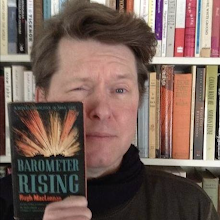The October 1912 issue of
Canada Monthly, purchased late last year for the humour – black humour – of its cover:
Agnes Deans Cameron's Last Article
"THE THAMES BY CANADIAN CANOE"
In fact, Miss Cameron survived, dodging sailboats and steamers, only to succumb to pneumonia shortly after her return home to Victoria.
"The liveliest, most entertaining, most thoroughly Canadian of the magazines published in Canada" was owned, edited and published by Herbert Vanderhoof, a Chicago publicity agent who made his fortune pushing land in our four westernmost provinces.
The District of Vanderhoof – "Geographic Centre of British Columbia" – was named in his honour.
It makes perfect sense that Miss Cameron was one of Herbert Vanderhoof's writers; she spent much of her forty-eight years encouraging western settlement. That trip down the Thames was made possible in part by an Ottawa that was eager to promote British immigration.
Agnes Deans Cameron isn't the biggest name in this particular issue; Isabel Ecclestone Mackay contributes a particularly bad poem. For my money – I paid $2.80 – the most interesting offering is this bit o' verse by Dorothy Livesay's mother:
Most writers in this "most thoroughly Canadian of the magazines published in Canada" are American. Lesser names like Wilbur D. Nesbit, best remembered for
"A Song for Flag Day", a jingoistic ode to the Stars and Stripes, populate its pages.
Canada Monthly was never intended to be a showcase for this country's writing, but as a means to sell the West. Nesbit's countryman Arthur I. Street contributes "How Many More? What the Business Man Can Make in Canada", in which he appeals to our greed:
An increase of nine and three-quarter millions in population, a million and a half in dwellings, and three-quarters of a million in the number of farms would mean an increase in farm values of nearly two billions. And that's your particular "baby", isn't it? Increase your land values? Isn't that where you make your money? Isn't that the temptation that leads you into a new country?
A century later the West is still chasing that "increase of nine and three-quarter millions in population".
The caption on this accompanying W.C. Sheppard [
sic] illustration reflects Street's optimism...
...as do the advertisements.
Twenty-two months later, on August 4, 1914, everything changed. It seems oddly appropriate that the pitch for property in Fraser Lake is followed by this advert for
the infamous Ross rifle:
"You Buy a Rifle to Last Your Life-time..."
The cruelest joke of all.
































